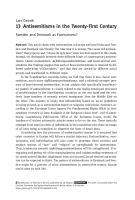Antisemitisms in the Twenty-First Century: Sweden and Denmark as Forerunners?
Author(s)
Publication Name
Publication Date
Publication Place
Publisher
Abstract
This article deals with antisemitism in Europe and post-Holocaust Sweden and Denmark specifically. The idea that it is always “the same old antisemitism” that pops up and “shows its ugly face” does not find support in this study. Instead, we distinguish between three different kinds of contemporary antisemitisms: Classic antisemitism, Aufklärungsantisemitismus, and Israel-derived antisemitism. Our findings suggest that each of these antisemitisms is inspired by different underlying “philosophies,” and that they are carried by different social groups and manifested in different ways. In the Scandinavian countries today, we find that there is less classic antisemitism, much more Aufklärungsantisemitismus, and a relatively stronger presence of Israel-derived antisemitism. In our analysis this specifically Scandinavian pattern of antisemitisms is closely related to the highly developed processes of modernization in the Scandinavian countries on the one hand and the relatively large numbers of recently arrived immigrants from the Middle East on the other. This appears to imply that antisemitism based on racial prejudices is losing ground, as is antisemitism based on religious convictions. However, according to the European Union Agency For Fundamental Rights (FRA) in Antisemitism: Overview of Data Available in the European Union 2007-2017 (Luxembourg: Luxembourg Publications Office of the European Union, 2018), the incidence of violent antisemitic attacks seems to be on the rise. These typically emanate from small pockets of individuals in the population who share an image of all Jews being accomplices to whatever the State of Israel does. Considering how the processes of modernization operate it is assumed that other countries in Europe will follow a similar trajectory. Rationalization, secularization, and individuation will also come to penetrate these societies and weaken notions of “race” and “religion” as springboards for antisemitism. Thus, tendencies towards Aufklärungsantisemitismus will be strengthened. If integrating and getting rid of the marginalization and condescending treatment of its newly arrived Muslim inhabitants does not succeed, Israel-derived antisemitism can be expected to thrive. The pattern of antisemitisms in Denmark and Sweden might be a preview of what antisemitisms in twenty-first-century Europe could come to look like.
Topics
Antisemitism Antisemitism: Muslim Antisemitism: Left-Wing Antisemitism: New Antisemitism Israel Criticism Main Topic: Antisemitism
Editor
Genre
Geographic Coverage
Copyright Info
This work is licensed under the Creative Commons Attribution-NonCommercial-NoDerivatives 4.0 License
Original Language
Page Number
233-268
ISBN/ISSN
978-3-11-063193-7
DOI
Link
Link to article including link to pdf, Antisemitisms in the Twenty-First Century: Sweden and Denmark as Forerunners?
Bibliographic Information
Antisemitisms in the Twenty-First Century: Sweden and Denmark as Forerunners?. . 2019: 233-268. https://archive.jpr.org.uk/10.1515/9783110634822-015




